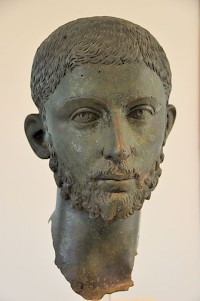Apollonius of Tyana (3)
Apollonius of Tyana: charismatic teacher and miracle worker (first century CE). Born in Tyana, he may have belonged to a branch of ancient philosophy called neo-Pythagoreanism. He received divine honors in the third century. Although the Athenian sophist (professional orator) Philostratus wrote a lengthy Life of Apollonius (summary), hardly anything about the sage is certain. However, there are several bits and pieces of information that may help us reconstruct something of the life of this man, who was and is frequently compared to the Jewish sage and miracle worker Jesus of Nazareth.
Apollonius' letters
There exists a large collection of Letters of Apollonius: it contains more than hundred pieces, most of them said to be written by the Tyanean, some by others, often short, sometimes long. Some letters are likely to be older than Life of Apollonius (LoA): e.g., Philostratus' description of Apollonius visit to Sparta (LoA 4.27) seems to be derived from Letter 63. Unfortunately, other letters are suspiciously similar to compositions by the author of the LoA. However, we can be certain that, although most letters were not written by the sage of Tyana, at least a substantial part of it is based on information about Apollonius that is older and perhaps more reliable than Philostratus' vie romancée. The problem is that we do not know which part.
If we exclude the letters that are obviously inspired by the LoA and some anti-christian fabrications, we get a remarkable picture. To start with, the author of the letters - whoever he was - wants us to believe that Apollonius was a neo-Pythagorean philosopher. Next, he shows us an Apollonius who is a hero of the Greek culture; the odd thing is that this Apollonius is sometimes anti-Roman. The first element pervades Philostratus' books too, but the second element is almost absent from the LoA. Because of this anti-Roman tendency, it may be argued that the Letters of Apollonius were composed in the 140s by someone living in Athens.
An additional element for dating the letters in these years, is the polemic between the stoic philosopher Euphrates of Tyre (†119) and the neo-Pythagorean Apollonius; this was an important debate in the mid-second century. Reading the letters said to be sent to the Roman philosopher C. Musonius Rufus (c.30-c.100), we get the impression that Musonius is the winner of the polemic;note this is, of course, too embarrassing to be invented by an admirer of the Tyanean. It must antedate the composition of the collection in the 140s, and may even reflect a real polemic.
In two of the letters to Euphrates, #16 and #17, we encounter an Apollonius who would have scared Philostratus to death: the author of these letters proudly confesses he is a magician, and goes on to give a positive interpretation of that word. These letters were certainly not invented by Philostratus.
You think it your duty to call philosophers who follow Pythagoras "magicians", and likewise also those who follow Orpheus. For my own part I think that those who follow no matter whom, ought to be called "magicians", if only they are determined to be divine and just men.note

The Letters of Apollonius are fabrications, but they serve to corroborate the tradition that the man from Tyana was a magician. Besides, the fact that someone decided to compose these letters in order to create a Greek, anti-Roman hero proves that Apollonius was by then a well-known figure. This is remarkable, since there are strong indications that Greek was not his native tongue.note (But not too remarkable: it must be remembered that great second century orators like Lucian and Favorinus of Arelate weren't native speakers either.)
The inevitable conclusion that Apollonius had become some sort of popular hero in the second century can be corroborated with a statement in the collection of biographies known as the Historia Augusta: the emperor Severus Alexander worshipped Apollonius.{{Historia Augusta, "Life of Severus Alexander" 29.2). This popularity is not without implications, as we will see below.